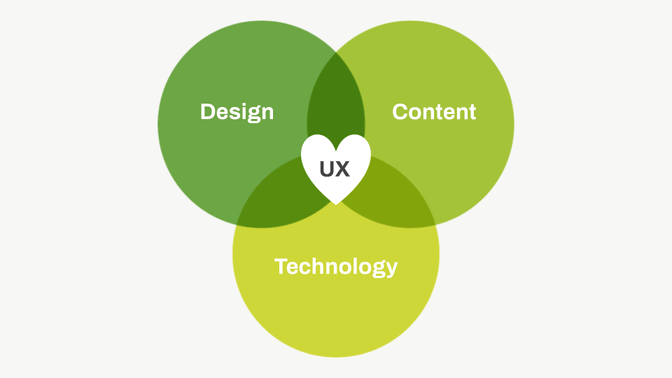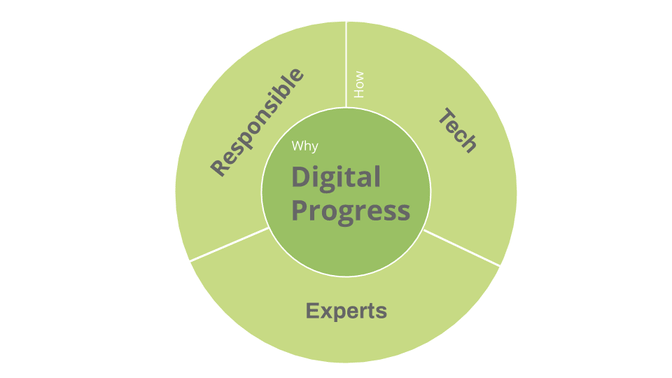Why do we recommend developing a content strategy early on in a web project? The answer is obvious: content is an integral part of any user experience. Alongside design and technology, content is ultimately what wins people over.

When we develop a content strategy, we first need to know what a company stands for. Thereafter we find out what users need when they browse through the company’s website. Then we match the two: We combine what a company stands for with the needs of its target groups to identify all of the relevant topics that we need to tackle on a website. This process also establishes key cornerstones for the information architecture and the user journey. Since content strategy provides elementary insights for the user experience, we recommend developing a content strategy right at the beginning of a web project. We do this in the following three steps.
Step 1: What does the company stand for?
The clearer the message, the stronger the branding effect
Every single page that a visitor views on a website must convey the company’s core message. Whether it is the ‘About Us’ page or the shop’s checkout process,the experience we provide via design, imagery, tonality and content must feed into a core message. This makes it clear what a company stands for, and embeds this message in their clients’ hearts and minds for the long term.
The clearer the message, the more precise the editorial team can be
Clarity also helps the editorial team. The simpler and more specific a website’s core message and topics, the easier the editorial team’s work gets. This allows them to respond to the strategy in a specific, application-oriented way. Therefore, when we start working on a website, we always define the website’s core message first. We do this by looking at the brand’s promises and values. We study the communication strategy if there is one, and listen very carefully when the project team talk about their company. That’s how a core message is born. This process also highlights the core topics that drive a company. Does this sound a little cryptic? Let’s put the theory into practice, taking the example of our own agency's positioning.
Developing the core message and topics using the web agency Liip as an example
Liip stands for digital progress – everything we do reflects this. There are three core topics that are particularly relevant to us.
1. We act responsibly: For us digital progress isn’t something purely technological. Progress affects the entire ecosystem – including society and the well-being of our planet. We take this into account, and exercise this broad responsibility in our organisational structure and corporate culture.
2. We use technology to create new things: A glance at our projects and skills shows that we are at home in the digital world. Technology is our core business. We use it to help customers develop new things.
3. We are experts in our field: When a company collaborate with us, they are looking for expertise they don’t have themselves. This expertise represents Liip’s value. We also cultivate this in our external communications.
Wherever anyone sees us or reads about us, these three topics must be visible in our communications. Because they all feed into a single core message: digital progress.

Step 2: What is the target group looking for?
To avoid getting stuck in a company’s internal viewpoint, we listen very carefully to what our target group is looking for. We interview users to understand the target group. We ask what potential visitors are specifically looking for on a company’s website, what they find exciting, and what bores them. It also often helps to give them a navigation task and watch how they click through the existing website. Potential tasks include ‘buy product X’, ‘find the opening hours’, ‘register for a course’, or ‘find out if you like this company’. We use the insights gained from this to define target groups. We work closely with our behavioural psychologists and UX designers because identifying users’ needs is equally vital to the design process. Once the needs a clear, the developed content strategy, is summarised in a single sentence. Just because this makes life easier, always. The example of our own agency’s target groups will illustrate the process.
Target groups using the web agency Liip as an example
We defined four main target groups for Liip, and considered what they are looking for in our website.
Directors: Potential customers come to our website to find out if we can give their company a decisive edge in digital transformation.
Start-ups or incubators: Switzerland is known worldwide for its culture of innovation. We help these companies to implement their ideas. Entrepreneurs from these companies come to our website to see if we fit the innovative bill.
Product owners: Customers who are actually working with us are equally important. In defining target groups, we have described these customers as product owners.
Press: We represent a new type of entrepreneurship. We are convinced that modern companies not only keep an eye on their profits, but their social responsibility, too. The press helps us to convey this message to the world. Journalists should therefore be able to find out about our culture and values quickly and easily on our website.
NB: The target group of ‘potential employees’ has been omitted for the sake of simplicity.

Step 3: Bring the core message and target groups’ needs together
We have defined what the company stands for – in other words, we have the internal viewpoint. We have identified what target groups need from the website content – in other words, we also have the external viewpoint. Now we have to bring these internal and external viewpoints together. This results in specific topic areas. Specific formats also usually emerge. Think of it as ‘nailing the sweet spot’ – that perfect point where supply and demand coincide. In this step, Liip’s content strategists work closely with UX designers and, of course, our customers. We discuss the feasibility of the topic areas and potential formats – because there is nothing worse than a strategy that moves far too far away from your day-to-day business.
Bringing company topics and target group topics together using the web agency Liip as an example
Defining the core message and topics takes lots of sensitivity and creative work. Developing target groups is quite time consuming. Then comes the third step, which calls for combinatorics: we bring the first two activities together.
Topics relating to ‘responsibility’: Our culture and our organisational structure of ‘holacracy’ is of interest to the press. Our organisational structure is also of particular interest to people who are responsible for digital transformation in their own companies. The topics of ‘holacracy’ and ‘culture’ therefore pull our topics together perfectly with the needs of our target groups.
Topics relating to ‘technology’: Our projects and services demonstrate that we use technology to create real innovation. This is interesting to leaders who are looking for support with digital transformation. These topics are also relevant to start-ups who are looking for a concrete implementation partner in Liip. By setting out our projects and services, we can present ourselves as an agency, but also meet our target groups’ information needs.
Topics relating to ‘expertise’: Telling people about our expertise is all well and good. However, demonstrating our expertise is more convincing. We therefore give our experts plenty of space and freedom to plumb the depths of their knowledge and write about it. Not everyone may understand it, but it immediately shows our ‘product owner’ target group what we are capable of. Another thing that helps this target group to quickly assess our expertise is the tangible results of our work. The ‘Expert Topics’ and ‘Results’ sections allow us to perfectly combine our experts’ internal viewpoint with our readers’ thirst for knowledge.
And this serves as the basis for any content strategy: the messages and topics matrix. We can use this to define subtopics and formats, choose distribution channels and derive monitoring targets. The matrix also serves as a guiding light to direct all communication activities.

Lessons learned
To establish the basis of a content strategy, you need to know your company’s core message and core topics. You must then position yourself so that you cover exactly what your target group wants from you.
Checklist
Step 1: Define the core message
Find out what your company stands for – and formulate it in a way that a 12-year-old child would understand.
Step 2: Define target groups
Find out who visits your website and what they want from it.
Step 3: Find the ‘sweet spot’
Combine steps 1 and 2 to define which topics perfectly cover your target group’s questions and needs, and also make a convincing argument for your company to this target group.
Defining the core topics forms the basis of any Liip content strategy. To ensure that these topics will be similarly incorporated by the editorial team, we also tackle content governance.

